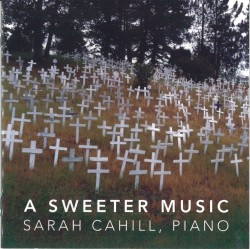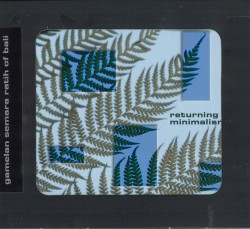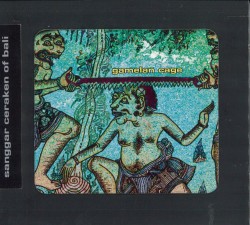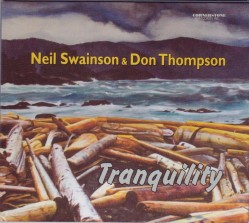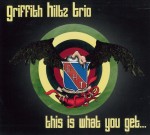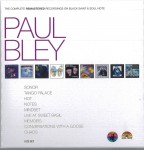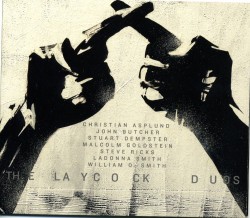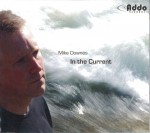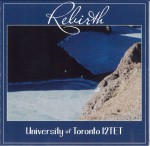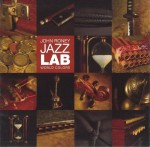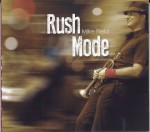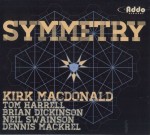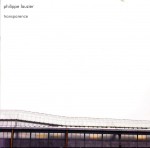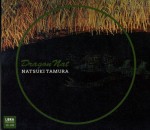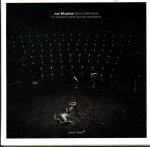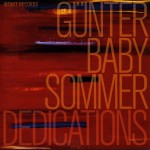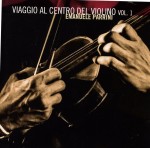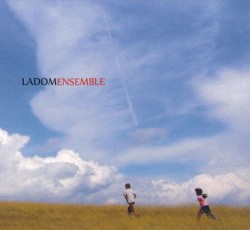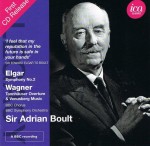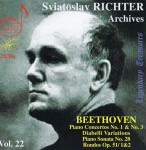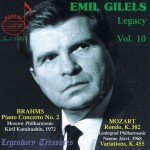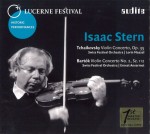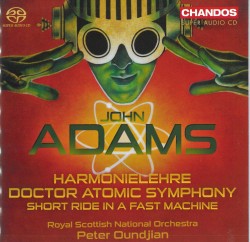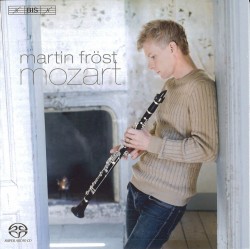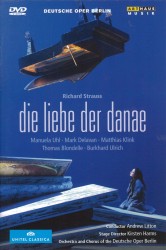2013 was a milestone year in many ways, one being the 100th anniversary of the riotous premiere of Stravinsky’s Rite of Spring. Further on in these pages you will find reviews of three new recordings which take very different approaches to this seminal work. But the year also marked the centenaries of a number of important composers, from Canadian pioneers John Weinzweig, Violet Archer and Henry Brant to iconic international figures including Benjamin Britten and Witold Lutosławski. I wish I could tell you that there were new recordings of works by the Canadians, but I am not aware of any. Both Britten and Lutosławski however have been very well served over the past year.
On the local scene this year Britten has been a recurring presence on TSO programs, the COC recently completed a successful run of Peter Grimes and as you will know from WholeNote reviews there has been a wealth of recordings of his concertante works and operas.
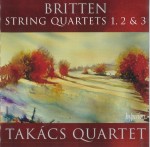 With a vast output in larger forms — more than a dozen operas and a plethora of orchestral, vocal and choral works — it is all too easy to overlook Britten as a composer of chamber music. There is however a substantial body of work encompassing innumerable combinations of solo instruments. Of particular note are the works for solo cello (three suites and a sonata with piano) written for Rostropovich and the nine for two violins, viola and cello including three numbered String Quartets. Hyperion has just released a new recording (CDA68004) of the latter featuring the celebrated Takács Quartet. String Quartet No.1 was written on commission from Elizabeth Sprague Coolidge while Britten was living in the United States in the early years of World War Two. It is less conventional and somewhat harsher than his earlier works, showing the influence of Stravinsky and Copland. String Quartet No.2 was composed after his return to England and premiered just months after the triumphal staging of Peter Grimes at Saddler’s Wells, the work that brought Britten international stardom. Most notable in this quartet is the extended third movement, a “Chacony” in homage to Henry Purcell whose work he would further celebrate the following year in The Young Person’s Guide to the Orchestra.
With a vast output in larger forms — more than a dozen operas and a plethora of orchestral, vocal and choral works — it is all too easy to overlook Britten as a composer of chamber music. There is however a substantial body of work encompassing innumerable combinations of solo instruments. Of particular note are the works for solo cello (three suites and a sonata with piano) written for Rostropovich and the nine for two violins, viola and cello including three numbered String Quartets. Hyperion has just released a new recording (CDA68004) of the latter featuring the celebrated Takács Quartet. String Quartet No.1 was written on commission from Elizabeth Sprague Coolidge while Britten was living in the United States in the early years of World War Two. It is less conventional and somewhat harsher than his earlier works, showing the influence of Stravinsky and Copland. String Quartet No.2 was composed after his return to England and premiered just months after the triumphal staging of Peter Grimes at Saddler’s Wells, the work that brought Britten international stardom. Most notable in this quartet is the extended third movement, a “Chacony” in homage to Henry Purcell whose work he would further celebrate the following year in The Young Person’s Guide to the Orchestra.
Britten did not return to the string quartet form until 30 years later, in 1975, just one year before his death. String Quartet No.3 is related to his final opera Death in Venice, and was in fact partially composed in the Italian city. Following a spiky “Burleske” reminiscent of Shostakovich (who had died that year) the final movement’s “Recitative” incorporates a barcarole reminding us of the gondolas of Venice and its concluding “Passacaglia” is set in the key of E major so closely associated with Gustav von Auschenbach, the protagonist of the opera.
Bookending Britten’s early mature offerings and his final output, these quartets, insightfully and exquisitely played by the Takács, offer quiet commentary on the larger-than-life works through which we have come to best know this composer.
Concert note: Associates of the Toronto Symphony will perform Britten’s String Quartet No.2 at Trinity-St. Paul’s Centre on January 20.
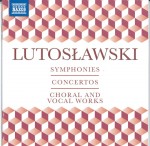 Witold Lutosławski has also been honoured through recordings this past year, though more in the form of re-issues than new releases. The Polish national label Polskie Nagrania released Witold Lutosławski – Centenary Edition an 8-CD set earlier this year (reviewed in the online version of Editor’s Corner in June) which featured historic recordings, many of which were conducted by Lutosławski himself. Now Naxos has collected its existing recordings and issued a 10-CD box Lutosławski – Symphonies; Concertos; Choral and Vocal Works (8.501066) featuring the Polish National Radio Symphony Orchestra (and others) under the direction of Antoni Wit. Containing virtually all of the larger works it is a comprehensive set of thrilling performances in glorious sound. Originally issued as individual discs the collection gives the opportunity to listen to the complete oeuvre in any number of ways. As I write this I am enjoying exploring the symphonic works in chronological order: Symphony No.1 (1941–47); Concerto for Orchestra (1950-54); Symphony No.2 (1965–67); Symphony No.3 (1981–83); Symphony No.4 (1988–92), works which span the entirety of Lutosławski’s creative output. It is most interesting to hear not only the stylistic but also the formal developments from the mostly traditional first symphony (in four movements) through the Bartókian concerto (three movements) to the second symphony (two movements) and the final mature works both in a single movement. Another highlight is the Cello Concerto, written for Rostropovich but performed here by ARD- and Prague Spring Competition-winning Polish cellist Andrzej Bauer who, among other studies, worked with William Pleeth for two years in London on a scholarship funded by Lutosławski and who has obviously made this concerto a signature piece.
Witold Lutosławski has also been honoured through recordings this past year, though more in the form of re-issues than new releases. The Polish national label Polskie Nagrania released Witold Lutosławski – Centenary Edition an 8-CD set earlier this year (reviewed in the online version of Editor’s Corner in June) which featured historic recordings, many of which were conducted by Lutosławski himself. Now Naxos has collected its existing recordings and issued a 10-CD box Lutosławski – Symphonies; Concertos; Choral and Vocal Works (8.501066) featuring the Polish National Radio Symphony Orchestra (and others) under the direction of Antoni Wit. Containing virtually all of the larger works it is a comprehensive set of thrilling performances in glorious sound. Originally issued as individual discs the collection gives the opportunity to listen to the complete oeuvre in any number of ways. As I write this I am enjoying exploring the symphonic works in chronological order: Symphony No.1 (1941–47); Concerto for Orchestra (1950-54); Symphony No.2 (1965–67); Symphony No.3 (1981–83); Symphony No.4 (1988–92), works which span the entirety of Lutosławski’s creative output. It is most interesting to hear not only the stylistic but also the formal developments from the mostly traditional first symphony (in four movements) through the Bartókian concerto (three movements) to the second symphony (two movements) and the final mature works both in a single movement. Another highlight is the Cello Concerto, written for Rostropovich but performed here by ARD- and Prague Spring Competition-winning Polish cellist Andrzej Bauer who, among other studies, worked with William Pleeth for two years in London on a scholarship funded by Lutosławski and who has obviously made this concerto a signature piece.
While the first nine discs are reissues of Wit’s definitive Naxos recordings, the final disc comprises the last concert that Lutosławski conducted in his lifetime. That took place at the Premiere Dance Theatre at Harbourfront in Toronto on October 24, 1993 and featured violinist Fujiko Imajishi, soprano Valdine Anderson and the New Music Concerts Ensemble. You can read NMC artistic director Robert Aitken’s reminiscences of the great Polish composer elsewhere in these pages.
Although Lutosławski wrote almost exclusively for large ensembles there is one very important transitional work that it is a shame not to have included here, the String Quartet from 1964 in which the composer takes his aleatoric approach to composition to new levels. The Polskie Nagrania set mentioned above includes a performance by the LaSalle Quartet who premiered the work, recorded at the Warsaw Autumn Festival in 1965. A 2013 Hyperion recording by the Royal Quartet (reviewed in this column last May) is also highly recommended.
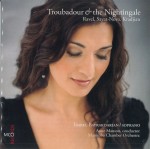 I’m often taken by the frequencies of coincidence in my life. One such occurrence relates to discs received in the past two months. Trobairitz, the feminine form of troubadour, was not a word in my vocabulary until the release of an ATMA CD by that name reviewed by Hans de Groot in last month’s WholeNote. De Groot mentioned that the only trobairitz song to have survived in both melody and words is A Chantar by the Contessa de Día and that it is not included in the recording by Shannon Mercer and La Nef. I have just received a new disc featuring Isabel Bayrakdarian entitled Troubadour & the Nightingale with the Manitoba Chamber Orchestra under Anne Manson’s direction (MCO 013001 themco.ca). Lo and behold this recording of arrangements and original compositions by Serouj Kradjian includes the suite Trobairitz Ysabella in which the ancient song A Chantar is featured ...
I’m often taken by the frequencies of coincidence in my life. One such occurrence relates to discs received in the past two months. Trobairitz, the feminine form of troubadour, was not a word in my vocabulary until the release of an ATMA CD by that name reviewed by Hans de Groot in last month’s WholeNote. De Groot mentioned that the only trobairitz song to have survived in both melody and words is A Chantar by the Contessa de Día and that it is not included in the recording by Shannon Mercer and La Nef. I have just received a new disc featuring Isabel Bayrakdarian entitled Troubadour & the Nightingale with the Manitoba Chamber Orchestra under Anne Manson’s direction (MCO 013001 themco.ca). Lo and behold this recording of arrangements and original compositions by Serouj Kradjian includes the suite Trobairitz Ysabella in which the ancient song A Chantar is featured ...
In Kradjian’s illuminating introductory essay he explains the project originated in a discussion with conductor Manson about the book The Ornament of the World: How Muslims, Jews and Christians Created a Culture of Tolerance in Medieval Spain by Maria Rosa Menocal, which explores the golden age when the arts, literature and science flourished for 500 years in an atmosphere of tolerance. This eventually led him to the lives, poetry and music of the trobairitz of Occitania in the south of France bordering Spain, who were active for a brief 60 years in the 12th and 13th centuries during the Crusades. Evidently when the men returned from the wars social values once again regressed to the point where women were no longer allowed creative expression. Kradjian was inspired by his readings to compose the song cycle about Ysabella for his wife Bayrakdarian and the Manitoba Chamber Orchestra. For this attractive and evocative work the basic strings of the MCO are complemented by clarinet, oud, guitar and percussion.
In keeping with the theme, Kradjian arranged and orchestrated four songs by latter-day Armenian troubadour Sayat-Nova, born Haroutiun Sayatian in 1712, who served for a time at the court of Heracle II, King of Georgia, until his attraction for the king’s daughter led to expulsion. To complete the set Kradjian also arranged the beautiful Greek songs of Maurice Ravel and that composer’s setting of Kaddish, a Jewish prayer in Aramaic magnifying and glorifying God. Throughout the disc Bayrakdarian is in fine form and full voice, often sending shivers down the listener’s spine.
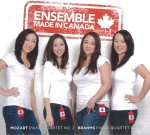 In brief: Rachel Mercer is a cellist whose career I’ve been following since her university days when as a broadcaster at CJRT I had the opportunity to record the brilliant young Metro Quartet. Mercer went on to an international chamber career with Israel’s Aviv Quartet (2002-10) and since returning to Toronto has been a member of the Mayumi Seiler Trio (with pianist Angela Park), the Mercer-Park Duo and Ensemble Made In Canada. This latter is a piano quartet in which Mercer and Park are joined by other local young lionesses Elissa Lee (violin) and Sharon Wei (viola). The EMIC’s debut CD (ensemblemadeincanada.com) features the second piano quartet of Mozart and the third of Brahms in dramatic, nuanced and, where appropriate, playful performances. Produced by Scott St. John and EMIC and recorded at Glenn Gould Studio in August 2012, the sound is everything you would hope for (and expect). Incidentally, as the winner of the 2009 Canada Council Musical Instrument Bank Competition, Mercer was awarded the use of the 1696 Bonjour Stradivarius cello from 2009 to 2012 and it can be heard on this fine recording.
In brief: Rachel Mercer is a cellist whose career I’ve been following since her university days when as a broadcaster at CJRT I had the opportunity to record the brilliant young Metro Quartet. Mercer went on to an international chamber career with Israel’s Aviv Quartet (2002-10) and since returning to Toronto has been a member of the Mayumi Seiler Trio (with pianist Angela Park), the Mercer-Park Duo and Ensemble Made In Canada. This latter is a piano quartet in which Mercer and Park are joined by other local young lionesses Elissa Lee (violin) and Sharon Wei (viola). The EMIC’s debut CD (ensemblemadeincanada.com) features the second piano quartet of Mozart and the third of Brahms in dramatic, nuanced and, where appropriate, playful performances. Produced by Scott St. John and EMIC and recorded at Glenn Gould Studio in August 2012, the sound is everything you would hope for (and expect). Incidentally, as the winner of the 2009 Canada Council Musical Instrument Bank Competition, Mercer was awarded the use of the 1696 Bonjour Stradivarius cello from 2009 to 2012 and it can be heard on this fine recording.
Concert note: Ensemble Made In Canada performs at the Kitchener-Waterloo Chamber Music Society on December 3.
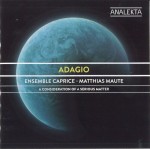 Analekta recently released a disc which I must confess I was sceptical about when I first came across it. I was afraid that Adagio (AN 2 9848) featuring Ensemble Caprice under Matthias Maute would turn out to be another compilation of “the world’s most beautiful melodies” or some such saccharine fare. I’m glad that I gave it a chance though; it turned out to be a thoughtful collection with some surprising inclusions. Although overall a baroque offering — Zelenka, Albinoni, Carissimi, Allegri and Bach are all present — Maute explains the premise of the project in his program note as having been inspired by Charles Ives’ The Unanswered Question and its subtitle A Consideration of a Serious Matter. He says “This wonderful title soon became the programmatic idea behind our recording of adagios throughout the centuries. [...] all meditations on the fundamental questions of life and death [expressing] something impossible to communicate through words.” It is an interesting concept and one which works very well for the most part with its balance of instrumental and choral works and Shannon Mercer’s wonderful rendering of Bach’s Ich habe genug. Maute has contributed an original prelude, used as a bridge to his arrangement of Satie’s lovely Gymnopédie No.1 and also an arrangement of Chopin’s Prélude Op.28, No.4. I only have two reservations about the disc: I would rather have heard the string version of Barber’s famous Adagio rather than the later choral setting of Agnus Dei using the same melody; I found the inclusion of Allegri’s Miserere, lovely as it is, to be too much in the context — too long in relation to the other selections, and simply too liturgical.
Analekta recently released a disc which I must confess I was sceptical about when I first came across it. I was afraid that Adagio (AN 2 9848) featuring Ensemble Caprice under Matthias Maute would turn out to be another compilation of “the world’s most beautiful melodies” or some such saccharine fare. I’m glad that I gave it a chance though; it turned out to be a thoughtful collection with some surprising inclusions. Although overall a baroque offering — Zelenka, Albinoni, Carissimi, Allegri and Bach are all present — Maute explains the premise of the project in his program note as having been inspired by Charles Ives’ The Unanswered Question and its subtitle A Consideration of a Serious Matter. He says “This wonderful title soon became the programmatic idea behind our recording of adagios throughout the centuries. [...] all meditations on the fundamental questions of life and death [expressing] something impossible to communicate through words.” It is an interesting concept and one which works very well for the most part with its balance of instrumental and choral works and Shannon Mercer’s wonderful rendering of Bach’s Ich habe genug. Maute has contributed an original prelude, used as a bridge to his arrangement of Satie’s lovely Gymnopédie No.1 and also an arrangement of Chopin’s Prélude Op.28, No.4. I only have two reservations about the disc: I would rather have heard the string version of Barber’s famous Adagio rather than the later choral setting of Agnus Dei using the same melody; I found the inclusion of Allegri’s Miserere, lovely as it is, to be too much in the context — too long in relation to the other selections, and simply too liturgical.
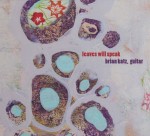
Two excellent and quite different acoustic guitar discs came my way this month. The first is by local stalwart of the jazz and independent music scenes, Brian Katz and the second features Newfoundland Django-style jazz guitarist Duane Andrews joined by country picker Craig Young. Leaves Will Speak (briankatz.com) is theresult of two years in the studio although more accurately it has been more than three decades in the making since that day in 1980 when Brian Katz decided that the nylon-string guitar would be his instrument of choice. Listening to this disc I was not surprised to find that Katz studied with Ralph Towner whose recordings with Oregon and the Paul Winter Consort were an integral part of the soundtrack to my formative years. But his influences and inspirations extend to many forms including jazz standards, free improvisation, klezmer, world, classical and new music. The 18 solo tracks on the album showcase the full range of Katz’ diverse musical world. With only one exception, an arrangement of an anonymous Italian Renaissance Danza, the tracks are original, most through-composed but some improvised in the recording studio. The sound is crisp and warm with a minimum of finger noise and the booklet is comprehensive with an informative essay about Katz’ background and approaches, and descriptive notes for each piece.
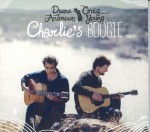 Charlie’s Boogie (charliesboogie.com) brings together a number of styles of steel-string guitar picking, with Duane Andrews and Craig Young each bringing their own distinctive influences to the mix. From traditional North American country music and fiddle tunes, rags and reels through the blues (via Bill Monroe) and of course “Hot Club of France” style jazz, there’s even one singer-songwriter type offering, Jerry Faires’ homage to his guitar, “The D-18 Song.” Andrews has created a unique blend of Newfoundland traditional music and jazz guitar (he graduated with honours from jazz studies at St. Francis-Xavier University in Nova Scotia and went on to composition studies in Paris and Marseilles). Young, also a native of Newfoundland, left home for Alberta in 1993 and later relocated to Nashville, Tennessee as a member of the Terri Clark band, playing at the Grand Ole Opry and the like. Some four Canadian Country Music Awards later he’s back home in Newfoundland teaching and pickin’ up a storm with Andrews. Although both are composers in their own right, the album features only one track by each with the rest devoted to cover versions of the stuff they enjoy most. Man, these guys are hot!
Charlie’s Boogie (charliesboogie.com) brings together a number of styles of steel-string guitar picking, with Duane Andrews and Craig Young each bringing their own distinctive influences to the mix. From traditional North American country music and fiddle tunes, rags and reels through the blues (via Bill Monroe) and of course “Hot Club of France” style jazz, there’s even one singer-songwriter type offering, Jerry Faires’ homage to his guitar, “The D-18 Song.” Andrews has created a unique blend of Newfoundland traditional music and jazz guitar (he graduated with honours from jazz studies at St. Francis-Xavier University in Nova Scotia and went on to composition studies in Paris and Marseilles). Young, also a native of Newfoundland, left home for Alberta in 1993 and later relocated to Nashville, Tennessee as a member of the Terri Clark band, playing at the Grand Ole Opry and the like. Some four Canadian Country Music Awards later he’s back home in Newfoundland teaching and pickin’ up a storm with Andrews. Although both are composers in their own right, the album features only one track by each with the rest devoted to cover versions of the stuff they enjoy most. Man, these guys are hot!
We welcome your feedback and invite submissions. CDs and comments should be sent to: The WholeNote, Centre for Social Innovation, 503–720 Bathurst St., Toronto ON, M5S 2R4. We also encourage you to visit our website thewholenote.com where you can find added features including direct links to performers, composers, record labels and additional, expanded and archival reviews.
—David Olds, DISCoveries Editor
discoveries@thewholenote.com
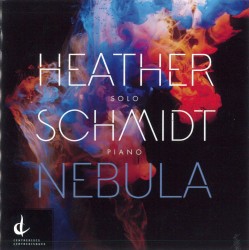 Nebula – solo piano music of Heather Schmidt
Nebula – solo piano music of Heather Schmidt

